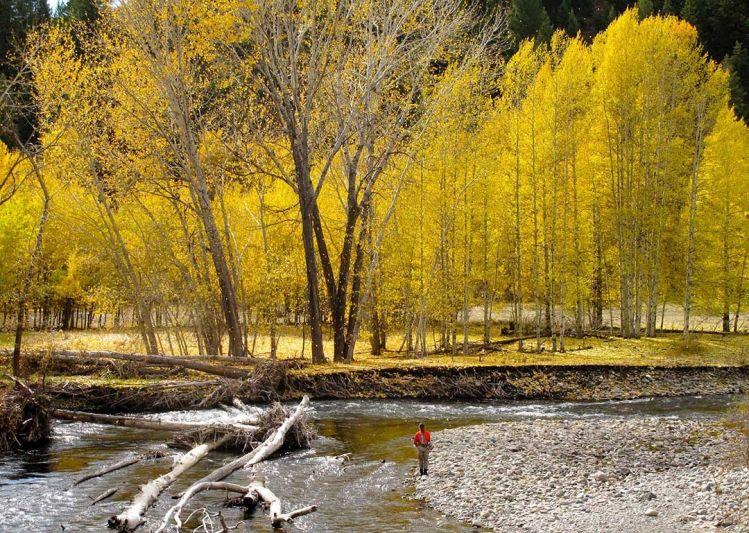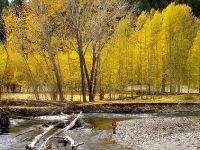From: 11/02/2017
To: 11/15/2017
Type of Water: Freshwater
Species: Steelhead, Rainbow trout, Brown trout, Cutthroat, Whitefish
Autumnal light can play tricks with an angler’s vision. When the sun is out, it is bright and low on the horizon, making it difficult to see a fly on the water. When the sun is obscured by clouds, colors fade to grey making a fly difficult to see on the water. Whether dealing with glooming light or gleaming darkness there are a few tricks anglers need to employ to keep their vision in tune: a good pair of polarized glasses, a high vis post on the fly, and a plan for how position themselves in the river relative to the intense glare.
Silver Creek
The Creek will continue to fish well in the late afternoon, especially on milder days. Expect decent numbers of Baetis in a short, concentrated burst which should get most of the fish looking up. To match this hatch, have a good selectio View more...Autumnal light can play tricks with an angler’s vision. When the sun is out, it is bright and low on the horizon, making it difficult to see a fly on the water. When the sun is obscured by clouds, colors fade to grey making a fly difficult to see on the water. Whether dealing with glooming light or gleaming darkness there are a few tricks anglers need to employ to keep their vision in tune: a good pair of polarized glasses, a high vis post on the fly, and a plan for how position themselves in the river relative to the intense glare.
Silver Creek
The Creek will continue to fish well in the late afternoon, especially on milder days. Expect decent numbers of Baetis in a short, concentrated burst which should get most of the fish looking up. To match this hatch, have a good selection of duns, cripples, and spinners tied by the House of Harrop in size 20-24 to guarantee success. Prior to and right after the hatch, nymphing dry dropper style with size 24-16 Pheasant Tails, Baetis nymphs, and olive and red Zebra Midge is effective. Keep in mind, the upper reach of Silver Creek through the Nature Conservancy section to the Highway 21 bridge closes the end of this month.
Big Wood
The fishing has been good between 11am and 3pm. There has been a decent Fall Baetis hatch starting around noon and plenty of midge activity as well. The fish are feeding aggressively during this short window. With the colder temperatures, the fish have transitioned into their winter holding water, so don't expect to find fish spread out in the fast, shallow riffles; instead, focus your attention on the deeper water, seams, and tailouts. A patient angler will find surface-feeding fish during the prime time; however, the most productive method is still nymphing. Try a dry dropper or a Euro style rig. The biggest challenge now is keeping the falling leaves off your fly.
Upper Lost
Trail Creek Pass is still open and should remain so for the next several weeks; however, once the snow falls, the pass will close. The fishing on the upper Lost is slow, except for a very short window in the late afternoon. Fish can still be taken on terrestrials as well as smaller dries like Caddis or Baetis, but nymphing is the most productive.
The Lost Below Mackay
The flows continue to hover around 290 CFS which is about 100 CFS higher than average. In the mid to late afternoon expect to see a few midges with good numbers of Fall Baetis. Try a single or double nymph rig with heavy tungsten beads fished on a long leader Euro Style or on a long Tenkara rod. Also, a simple dry dropper rig with a long leader on a traditional rod is effective for greater distance and delicate presentations for spooky fish.
Salmon
The temps can easily start in the teens and hover right around freezing this time of year in the Stanley Basin. However, there is still the potential for day time temps to reach 50. Either way, fishing the slower buckets during the pleasant time of day will produce good numbers of whitefish and trout.
South Fork of the Boise
With snow in the forecast, keep in mind the road can become very slick. When heading to the South Fork during the late fall and winter months be sure to have chains and a four-wheel drive. The fish are active in the and around the shallow riffles and runs where you can find structure during the pleasant time of day. For dries, go small. Try size 18 caddis in peacock, brown, black, and olive as well as Harrop's Baetis patterns in size 18-24. In the slower runs, the fish are typically feeding on midge, so have a good supply of midge dry and emerger patterns. Of course, nymphing Euro Style or Dry Dropper is very productive when you see no feeding fish.






